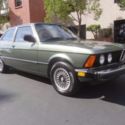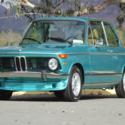1980 bmw 320i, Collectors Condition, One of a kind, Zypressen green metallic
- Price:
- Condition: Used
- Make: BMW
- Model: 3-Series
- Type: Coupe
- Trim: 320i
- Year: 1980
- Mileage: 305,000
- VIN: 7161973
- Color: Green
- Engine size: 2.0l
- Number of cylinders: 4
- Power options: Air Conditioning
- Fuel: Gasoline
- Transmission: Manual
- Drive type: RWD
- Interior color: Tan
- Drive side: Left-hand drive
- Options: Cassette Player, Sunroof
- Vehicle Title: Clear
- Location: San Diego, California, United States
Description
1980 BMW 320i Coupe1980 BMW 320i Coupe.This is a beautiful 5 speed manualCoupe with only305koriginal miles! Vehicle is in excellent shape! It is absolutely original and beautifully maintained in every respect! This car is a must see, a real head turner! The 4 Cylinder engine gives good performance and saves on gas too! The sports tuned suspension hugs the road like nobody's business. All scheduled maintenance, always garaged!
**** Very Rare Zypressen green metallic exteriorPaintin excellent Collectors condition, Recaro sport BMW seats, Air conditioning blows very cold, Power side mirrorsand many more options. The Leather interior of this ride is nothing less than perfect and is a sign of the excellent care and attention that this vehicle has seen since it was new. The original Carpet shows like new as well.Recently serviced, everything under the hood is in perfect shape.
The BMW package will completely surround you in both comfort and class. The package includes:6 Cylinder, 5 Speed Manual Transmission, Rear 2 wheel drive, 2.0 Liter Injected,Alloy wheels, Bilstien Shocks, Power locks, power sunroof, power windows. AC blows cold, Rear window defroster, AM / FM, Cd Player.This is a rust free, all original California Car!
Please feel free to contact me directly with any questions (858) 733 1030David
HISTORY
BMW E21 is the body designation for the first BMW 3 Series compact executive car, produced by BMW from 1975 to 1983. This series was the immediate successor to theBMW 2002and was superseded by theBMW E30platform.Under the direction of its 51% percent shareholder, Herbert Quandt, BMW decided upon a replacement for their aging2002. Without it, there was the distinct possibility of BMW leaving its core mission of building driver oriented cars, and alienating an existing customer base long enamored with the company’s2002 model. Paul Bracq, Director of Design at BMW from 1970–1974, is credited with setting the design direction of the E213 Series, while Wilhelm Hofmeister is credited with first drawing the small forward wedge at the base of the C-pillar, a strong design trait of the first 3 Series. In 1975 Claus Luthe replaced Bracq and became the owner of the project. In July 1975, BMW’s Board of Management first presented this new model series in theMunich Olympic Stadiumfor public appraisal. The frontal view of the new car was dominated by the BMW trademark kidney grille standing out clearly from the radiator cover.
The wedge shape of the two-door model was distinctive, extending all the way to the unusually high rear end. In response to criticism of the tail design, a black plastic trim panel between the tail lights was added. The car’s styling was otherwise well received. Measuring 4355 millimeters (171.5 inches) in length, 1610 millimeters (63.4 inches) in width, and 1380 millimeters (54.3 inches) in height, the E21 Series continued the tradition of theNew Class. With the wheelbase measuring 2563 millimeters (100.9 in), there was little body overhang in the rear wheel drive design. The track measured 1364 millimeters (53.7 in) at the front, and 1377 millimeters (54.2 in) at the rear. The suspension incorporated rack and pinion steering andMcPherson strutsuspension at the front, and semi-trailing arm type independent suspension at the rear. The power assisted brakes were discs on the front wheels, while the rear wheels had drum brakes.
Initially, a Getrag four-speed manual was the standard transmission fitment. Five-speed Getrag gearboxes were fitted as standard in the 323i and others in later years, but were available at the car’s release as an option, with gear ratio sets favoring either performance or economy. Alternatively, purchasers could opt for the ZF 3 HP-22 three-speed automatic transmission. The cockpit design of the E21 marked the introduction of a new design concept, with the center console angled towards the driver. This feature has become part of BMW’s interior design philosophy for many years. As a sign of passive safety, all edges and control elements within the interior were rounded off and padded.At the E21’s release, three models were available: with 316 (1.6 litre), 318 (1.8 litre) and 320 (2.0 litre) versions of the BMW M10four cylinderengine. To draw clear visual distinction within the new model series, the 320 models came with dual headlights, while the 316 and 318 had single round headlights. At the end of 1975,the 320iwas introduced; the engine was fitted with Bosch K Jetronic fuel injection, delivering 125bhp (93kW) on premium grade gasoline. The 320i was a upgraded version of 320 with an M10 engine; Bosch K-Jetronic (LambdaO2) fuel injection, 125bhp (93kW; 127PS) and limited slip differential also as an option.
On Sep-28-17 at 15:52:06 PDT, seller added the following information:
I do Apologize for the typo! Vehicle is a 4 Cylinder 5 speed.
 1980 Bmw 320i,Collectors Condition, Zypressen green, Walk around video included
1980 Bmw 320i,Collectors Condition, Zypressen green, Walk around video included
Mileage: 305,000
 1978 BMW 320i 320i 90268 Miles Green 2 door Sedan 5-speed manual
1978 BMW 320i 320i 90268 Miles Green 2 door Sedan 5-speed manual
Mileage: 90,268
 1992 BMW 318i Convertible Lagunengrun Metallic Green e30 manual Great Condition!
1992 BMW 318i Convertible Lagunengrun Metallic Green e30 manual Great Condition!
Mileage: 177,000
 1974 BMW 2002 500 Miles Green Turkish Metallic Full Restoration Mint Condition
1974 BMW 2002 500 Miles Green Turkish Metallic Full Restoration Mint Condition
Mileage: 500
 1981 BMW 320i (e21) - Graphite Metallic
1981 BMW 320i (e21) - Graphite Metallic
Mileage: 137,204
 1990 BMW E30 Sedan JDM RHD M20 320i DELPHIN METALLIC Low Mileage
1990 BMW E30 Sedan JDM RHD M20 320i DELPHIN METALLIC Low Mileage
Mileage: 30,000
 BMW 1980 320i(e21)
BMW 1980 320i(e21)
Mileage: NA
 1980 BMW 320i
1980 BMW 320i
Mileage: 107,000
 1980 bmw 320i base 1.8l
1980 bmw 320i base 1.8l
Mileage: 216000
 1980 BMW 320I EXTREMELY CLEAN
1980 BMW 320I EXTREMELY CLEAN
Mileage: 117,500












